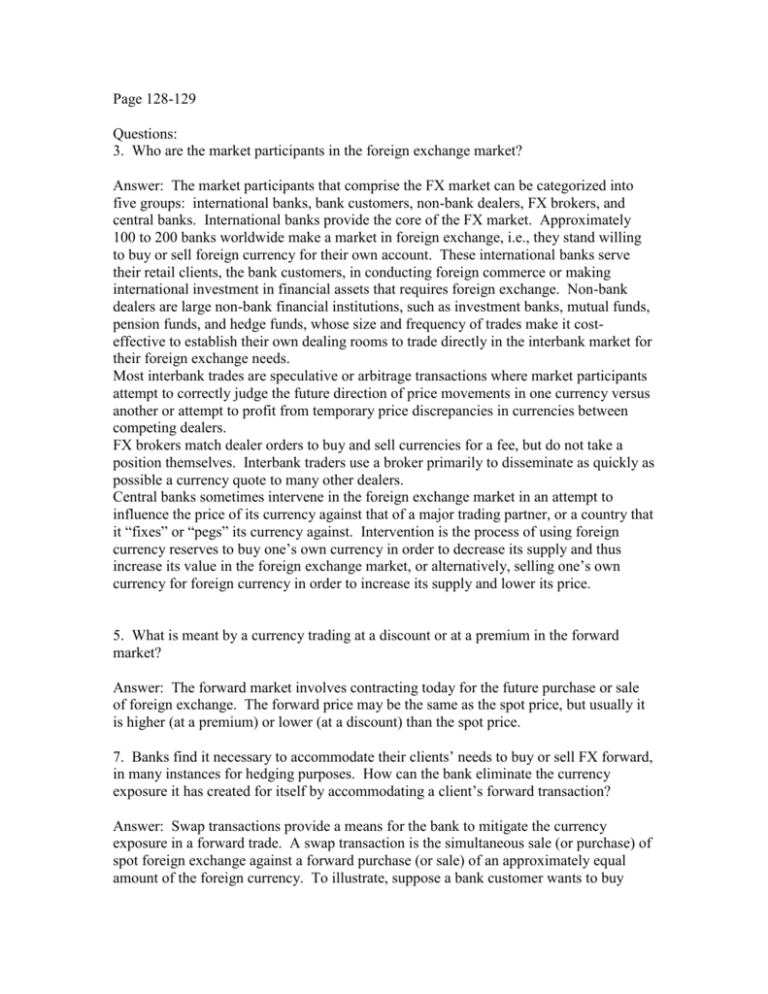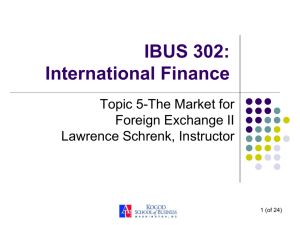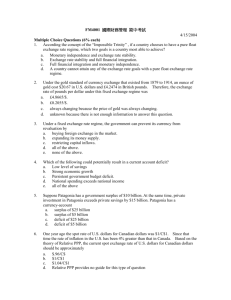Foreign Exchange Market: Key Concepts & Calculations
advertisement

Page 128-129 Questions: 3. Who are the market participants in the foreign exchange market? Answer: The market participants that comprise the FX market can be categorized into five groups: international banks, bank customers, non-bank dealers, FX brokers, and central banks. International banks provide the core of the FX market. Approximately 100 to 200 banks worldwide make a market in foreign exchange, i.e., they stand willing to buy or sell foreign currency for their own account. These international banks serve their retail clients, the bank customers, in conducting foreign commerce or making international investment in financial assets that requires foreign exchange. Non-bank dealers are large non-bank financial institutions, such as investment banks, mutual funds, pension funds, and hedge funds, whose size and frequency of trades make it costeffective to establish their own dealing rooms to trade directly in the interbank market for their foreign exchange needs. Most interbank trades are speculative or arbitrage transactions where market participants attempt to correctly judge the future direction of price movements in one currency versus another or attempt to profit from temporary price discrepancies in currencies between competing dealers. FX brokers match dealer orders to buy and sell currencies for a fee, but do not take a position themselves. Interbank traders use a broker primarily to disseminate as quickly as possible a currency quote to many other dealers. Central banks sometimes intervene in the foreign exchange market in an attempt to influence the price of its currency against that of a major trading partner, or a country that it “fixes” or “pegs” its currency against. Intervention is the process of using foreign currency reserves to buy one’s own currency in order to decrease its supply and thus increase its value in the foreign exchange market, or alternatively, selling one’s own currency for foreign currency in order to increase its supply and lower its price. 5. What is meant by a currency trading at a discount or at a premium in the forward market? Answer: The forward market involves contracting today for the future purchase or sale of foreign exchange. The forward price may be the same as the spot price, but usually it is higher (at a premium) or lower (at a discount) than the spot price. 7. Banks find it necessary to accommodate their clients’ needs to buy or sell FX forward, in many instances for hedging purposes. How can the bank eliminate the currency exposure it has created for itself by accommodating a client’s forward transaction? Answer: Swap transactions provide a means for the bank to mitigate the currency exposure in a forward trade. A swap transaction is the simultaneous sale (or purchase) of spot foreign exchange against a forward purchase (or sale) of an approximately equal amount of the foreign currency. To illustrate, suppose a bank customer wants to buy dollars three months forward against British pound sterling. The bank can handle this trade for its customer and simultaneously neutralize the exchange rate risk in the trade by selling (borrowed) British pound sterling spot against dollars. The bank will lend the dollars for three months until they are needed to deliver against the dollars it has sold forward. The British pounds received will be used to liquidate the sterling loan. 8. A CD/$ bank trader is currently quoting a small figure bid-ask of 35-40, when the rest of the market is trading at CD1.3436-CD1.3441. What is implied about the trader’s beliefs by his prices? Answer: The trader must think the Canadian dollar is going to appreciate against the U.S. dollar and therefore he is trying to increase his inventory of Canadian dollars by discouraging purchases of U.S. dollars by standing willing to buy $ at only CD1.3435/$1.00 and offering to sell from inventory at the slightly lower than market price of CD1.3440/$1.00. 9. What is triangular arbitrage? What is a condition that will give rise to a triangular arbitrage opportunity? Answer: Triangular arbitrage is the process of trading out of the U.S. dollar into a second currency, then trading it for a third currency, which is in turn traded for U.S. dollars. The purpose is to earn an arbitrage profit via trading from the second to the third currency when the direct exchange between the two is not in alignment with the cross exchange rate. Most, but not all, currency transactions go through the dollar. Certain banks specialize in making a direct market between non-dollar currencies, pricing at a narrower bid-ask spread than the cross-rate spread. Nevertheless, the implied cross-rate bid-ask quotations impose a discipline on the non-dollar market makers. If their direct quotes are not consistent with the cross exchange rates, a triangular arbitrage profit is possible. Problems: 1. Using Exhibit 5.4, calculate a cross-rate matrix for the euro, Swiss franc, Japanese yen, and the British pound. Use the most current American term quotes to calculate the crossrates so that the triangular matrix resulting is similar to the portion above the diagonal in Exhibit 5.6. Solution: The cross-rate formula we want to use is: S(j/k) = S($/k)/S($/j). The triangular matrix will contain 4 x (4 + 1)/2 = 10 elements. Euro Japan (100) Switzerland U.K ¥ 138.05 SF 1.5481 1.1214 £ .6873 .4979 .4440 $ 1.3112 .9498 .8470 1.9077 4. Using the spot and outright forward quotes in problem 3, determine the corresponding bid-ask spreads in points. Solution: Spot One-Month Three-Month Six-Month 5 10 15 20 5. Using Exhibit 5.4, calculate the one-, three-, and six-month forward premium or discount for the Canadian dollar versus the U.S. dollar using American term quotations. For simplicity, assume each month has 30 days. What is the interpretation of your results? Solution: The formula we want to use is: fN,CD = [(FN($/CD) - S($/CD/$)/S($/CD)] x 360/N f1,CD = [(.8037 - .8037)/.8037] x 360/30 = .0000 f3,CD = [(.8043 - .8037)/.8037] x 360/90 = .0030 f6,CD = [(.8057 - .8037)/.8037] x 360/180 = .0050 The pattern of forward premiums indicates that the Canadian dollar is trading at an increasing premium versus the U.S. dollar. That is, it becomes more expensive (in both absolute and percentage terms) to buy a Canadian dollar forward for U.S. dollars the further into the future one contracts. 8. Assume you are a trader with Deutsche Bank. From the quote screen on your computer terminal, you notice that Dresdner Bank is quoting €0.7627/$1.00 and Credit Suisse is offering SF1.1806/$1.00. You learn that UBS is making a direct market between the Swiss franc and the euro, with a current €/SF quote of .6395. Show how you can make a triangular arbitrage profit by trading at these prices. (Ignore bid-ask spreads for this problem.) Assume you have $5,000,000 with which to conduct the arbitrage. What happens if you initially sell dollars for Swiss francs? What €/SF price will eliminate triangular arbitrage? Solution: To make a triangular arbitrage profit the Deutsche Bank trader would sell $5,000,000 to Dresdner Bank at €0.7627/$1.00. This trade would yield €3,813,500= $5,000,000 x .7627. The Deutsche Bank trader would then sell the euros for Swiss francs to Union Bank of Switzerland at a price of €0.6395/SF1.00, yielding SF5,963,253 = €3,813,500/.6395. The Deutsche Bank trader will resell the Swiss francs to Credit Suisse for $5,051,036 = SF5,963,253/1.1806, yielding a triangular arbitrage profit of $51,036. If the Deutsche Bank trader initially sold $5,000,000 for Swiss francs, instead of euros, the trade would yield SF5,903,000 = $5,000,000 x 1.1806. The Swiss francs would in turn be traded for euros to UBS for €3,774,969= SF5,903,000 x .6395. The euros would be resold to Dresdner Bank for $4,949,481 = €3,774,969/.7627, or a loss of $50,519. Thus, it is necessary to conduct the triangular arbitrage in the correct order. The S(€/SF) cross exchange rate should be .7627/1.1806 = .6460. This is an equilibrium rate at which a triangular arbitrage profit will not exist. (The student can determine this for himself.) A profit results from the triangular arbitrage when dollars are first sold for euros because Swiss francs are purchased for euros at too low a rate in comparison to the equilibrium cross-rate, i.e., Swiss francs are purchased for only €0.6395/SF1.00 instead of the no-arbitrage rate of €0.6460/SF1.00. Similarly, when dollars are first sold for Swiss francs, an arbitrage loss results because Swiss francs are sold for euros at too low a rate, resulting in too few euros. That is, each Swiss franc is sold for €0.6395/SF1.00 instead of the higher no-arbitrage rate of €0.6460/SF1.00.






